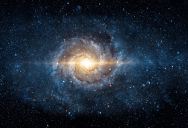Could A Flat Universe Exist? New Research Suggests A Solution.

People who talk about the Earth being flat are largely dismissed and laughed at. Most scientists agree, however, that the universe itself is actually flat.
There is so much evidence for this that it has been dubbed the ‘flatness problem’ because in many ways it doesn’t make sense that it would be flat.
This concept is explained by NASA:
“The density of the universe also determines its geometry. If the density of the universe exceeds the critical density, then the geometry of space is closed and positively curved like the surface of a sphere. This implies that initially parallel photon paths converge slowly, eventually cross, and return back to their starting point (if the universe lasts long enough). If the density of the universe is less than the critical density, then the geometry of space is open (infinite), and negatively curved like the surface of a saddle. If the density of the universe exactly equals the critical density, then the geometry of the universe is flat like a sheet of paper, and infinite in extent.”
It appears that we are living in this flat type of universe. Figuring out why we are living in this type of universe is not so easy.
In fact, it is extremely difficult.
Naturally, there are a number of proposals that could explain the situation.

One new paper, however, takes a novel approach.
The researchers suggest that the universe could be a non-singular bouncing cosmology. Basically means that the Big Bang was not a unique event, but something that occurs repeatedly through a much much longer history than we are aware of.
It is explained further:
“We found a novel natural model-independent mechanism for PBH (primordial black hole) formation during the HBB (hot Big Bang) radiation-dominated era, within the context of non-singular matter bouncing cosmologies. In particular, the enhancement of super-horizon curvature perturbations, during a matter contracting phase in combination with a short transitory period from the matter contracting to the HBB expanding Universe, can lead to enhanced curvature perturbations on small scales during the HBB phase, collapsing to form PBHs.”
Of course, this is just one new theory to add to the others out there, and it is not at all the accepted solution to the flatness problem.
The more potential answers, however, the better. This new study was published in the Journal of Cosmology and Astroparticle Physics.
You can also watch an informative video about the flatness problem and a potential solution here:
Wow, who would have thought a flat universe was such a real possibility?
Apparently we’re all a little behind the ball.
If you thought that was interesting, you might like to read about a second giant hole has opened up on the sun’s surface. Here’s what it means.

Sign up to get our BEST stories of the week straight to your inbox.




